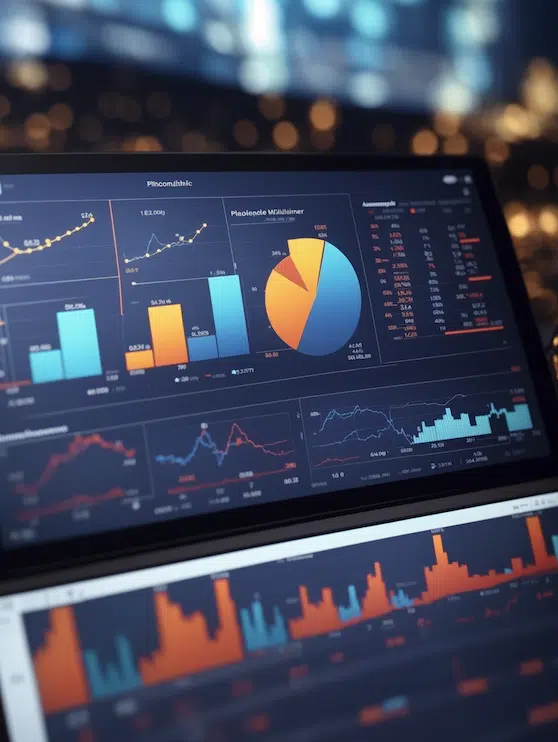While this article will explore the fundamentals of performance marketing, from key indicators such as Cost Per Mille (CPM) and Cost Per Click (CPC), (which are crucial cogs in the machinery that drives campaign success) we’ll also dive deeper into new tactics that truly put the advertiser at an advantage. We’ll navigate through potent avenues like social media and search engine optimization to massively expand your brand’s visibility.
We’ll unveil the significant impact of AI in enhancing and revolutionizing our approach to performance marketing strategies, and we’ll touch on how some performance marketing partners are measuring results to the last mile, connecting performance metrics to billed revenue on a purely pay-for-performance basis.
By sticking around, you’re set to gain insights on crafting winning strategies that not only target but captivate your audience effectively. Let’s get started.
Table Of Contents:
- What is Performance Marketing?
- Key Metrics in Performance Marketing
- Channels and Tactics for Effective Performance Marketing
- AI’s Role in Revolutionizing Performance Marketing
- Crafting a Winning Performance Marketing Strategy
- How Pay For Performance Agencies Enable Affordable Growth
- Wrapping Up
What is Performance Marketing?
In the heart of performance marketing lies a win-win scenario for both marketers, publishers and marketing agencies who are willing to have a little skin in the game. Here, companies get more bang for their buck as they are billed solely for measurable results. Whether it’s through social media buzz or search engine dominance, every penny spent aims to drive action.
Utilizing a mix of digital avenues, this method incorporates affiliate marketing to reward promoters with earnings for their endorsement of others’ merchandise. It also embraces highly targeted paid ads across platforms based on predictive analytics, making sure each ad reaches its intended audience with precision.
At the heart of this methodology lies a commitment to openness, transparency and responsibility, critical elements that cultivate a sense of credibility within the digital marketing community. Through the lens of omnichannel performance marketing (especially those powered by A.I., machine learning tools), advertisers are equipped with the ability to fine-tune their campaigns instantaneously, thanks to insights gleaned from real-time data analytics.
Performance Marketing vs Traditional Advertising
Ditching the old-school “pay-and-pray” model of traditional advertising, performance marketing offers something refreshingly accountable. Instead of shelling out hefty sums upfront without any guarantee of success, businesses now can track every dime against actual outcomes such as clicks or conversions.
This method not only ensures efficient use of budget but also empowers brands with actionable insights into customer behavior and preferences—a stark contrast to guessing games often associated with conventional methods. The dynamic nature of digital allows quick pivots and strategy adjustments based on solid data rather than hunches.
Key Metrics in Performance Marketing
Performance marketing turns the traditional advertising model on its head. Instead of paying upfront for a hopeful audience, advertisers pay based on actual results—be it clicks, conversions, or sales. So, what’s the real score when it comes to figuring out if you’re winning or not? Let’s talk key performance indicators: CPM, CPC, CPA, and LTV.
CPM (Cost per Thousand)
In the world of performance marketing campaigns, understanding your Cost per Thousand (CPM), or cost per thousand impressions is crucial. Grasping the concept of CPM allows advertisers to gauge the financial commitment required for their advertisements to garner a thousand eyeballs across different media channels. While not directly tied to action like some other metrics, it offers valuable insights into brand awareness efforts and helps optimize spending for maximum exposure.
CPC (Cost Per Click)
CPC stands out as one of the most direct measures of campaign engagement by quantifying what each click costs you within your online marketing strategy. This metric lets you gauge user interest levels across different channels—from social media to search engines—and refine targeting options accordingly to reduce wasted spend while driving more qualified traffic.
CPA (Cost Per Action)
The CPA metric hones in even further than CPC by measuring not just clicks but specific actions taken—like downloads or purchases—which are essential end goals for many campaigns. It enables advertisers to pinpoint exactly how much they’re paying for desired outcomes rather than just interaction opportunities making it indispensable for optimizing return on investment.
LTV (Lifetime Value)
Last but certainly not least is Lifetime Value—a predictive analytics powerhouse that forecasts long-term profitability from customers acquired through different performance marketing channels. This advanced metric helps businesses allocate resources effectively towards retaining high-value clients over time thereby ensuring sustained growth.
Channels and Tactics for Effective Performance Marketing
Social Media as a Powerhouse Channel
Social media isn’t just where we share memes and catch up with friends anymore. Now, it’s transformed into a pivotal force in boosting brand visibility and accelerating sales figures, establishing itself as a leading channel for performance marketing. Platforms like Facebook, Instagram, Twitter, and LinkedIn let advertisers target highly specific audiences based on interests, behaviors, location—you name it.
By harnessing this precise targeting feature, your advertisements are more apt to engage individuals inclined towards interacting with your site or purchasing directly from the promotion. And since you only pay when someone takes that action (thanks to the wonders of performance marketing), every dollar spent is done so with purpose.
The rise of influencer collaborations adds another layer. By partnering with individuals who have built trust with their followers—your potential customers—brands can amplify their message authentically. What’s more, as influencer marketing has continued to develop, compensation has become increasingly focused on real sales performance. Think of it not just as advertising but as recommendation at scale.
SEM and Native Advertising Essentials
Search Engine Marketing (SEM, also known as PPC), is perhaps the original performance marketing channel, capturing users at the moment they’re showing high intent; they’re literally searching for what you offer. Using platforms like Google Ads allows brands to appear right at the top of search engine results pages for relevant queries—a critical tactic considering the majority of online experiences start with a search engine.
In contrast but equally powerful are native ads which blend seamlessly into whatever content surrounds them—making them less intrusive and thus more engaging than traditional display ads. When executed well within reputable sites or social feeds these types of paid placements can significantly improve campaign performance by aligning closely with user interest without disrupting their experience.
And, while a pay-per-click model is certainly the definition of performance marketing, some A.I. marketing agencies have enabled a deeper level of performance-based compensation, by capturing their fees based on channeling sales qualified leads to the advertiser
AI’s Role in Revolutionizing Performance Marketing
Artificial intelligence (AI) is changing the game for performance marketing, making it possible to personalize campaigns like never before. Through the use of AI and instruments like ChatGPT in performance marketing, marketers are now able to sift through massive amounts of campaign data with pinpoint accuracy. This enables highly targeted audience engagement that wasn’t feasible at this scale or speed just a few years ago.
One significant optimization opportunity provided by AI lies in its ability to sift through and make sense of extensive datasets rapidly. Predictive analytics, an AI feature, helps marketers forecast future consumer behaviors based on historical data. This insight allows for more effective display ads and other marketing efforts by predicting what will resonate most with potential customers.
Artificial intelligence further revolutionizes the digital landscape by refining search engine marketing tactics and crafting native ads that merge effortlessly with online user interactions. Through SEM, AI optimizes ad spend by targeting users who show high intent but may not yet be familiar with your brand. Meanwhile, native ads powered by AI algorithms are so well-integrated within platforms that they feel less intrusive—improving user experience while subtly driving traffic towards desired actions.
How Cross Channel Marketing Takes Performance Marketing a Step Further
While many machine learning tools have been developed that systemize optimization for specific marketing channels, a Cross Channel Marketing approach, scales a company’s marketing budget based on actual revenues generated. Through CRM integration, machine learning technology attributes revenue to each individual marketing channel, adjusting budgets based on performance in real time.
By weaving together various channels into a single strategic framework, Cross Channel Marketing enhances both the scope and outcomes across numerous areas, ranging from collaborations with affiliates to social media marketing, PPC, SEO, Programmatic Display and even Video.
Key Takeaway:
AI is revolutionizing performance marketing by personalizing campaigns and analyzing data with precision, making targeted engagement easier and more effective. From predicting consumer behaviors to enhancing SEM strategies and creating seamless native ads, AI boosts ROI across all channels.
Crafting a Winning Performance Marketing Strategy
Creating a successful performance marketing strategy isn’t just about throwing everything at the wall and seeing what sticks. From the outset, it involves choosing wisely and making decisions based on knowledge. Defining your objectives upfront gives you a clear direction for your efforts, ensuring every move is purposeful.
But how do you choose which platforms to invest in? Simple: by understanding where your target audience spends their time. If they’re scrolling through social media all day, that’s where you should be too. Adopting this strategy enables the identification and utilization of marketing platforms most adept at captivating and retaining the attention of prospective clientele.
The Importance of Defining Objectives Upfront for Focused Efforts
To hit the ground running with any performance marketing campaign, clarity on what success looks like is crucial. Whether it’s increasing brand awareness or driving traffic to buy products, setting specific goals guides all subsequent actions and decisions within your campaign.
Kicking off, this early move sets the stage for accurately gauging triumph via later examinations and refinements.
How Pay For Performance Agencies Enable Affordable Growth
Ultimately for local businesses, whether we’re talking about SMBs or multi-location mid-market businesses, the ability to control your cost of marketing is critical. Meanwhile, the machine learning tools and techniques we’ve overviewed today have created the ability for marketing agencies like SaaSQL to create true pay-for-performance programs, in which company’s only pay when sales are closed. A couple of common models include:
Pay-Per-Lead Performance Marketing
In this model, company’s establish the value of a lead based on their conversion rates. An example of the thought process might go something like this: For every 10 leads, the company in question is able to convert 20% to a paying customer, at an average transaction value of $500. Therefore, getting 10 new leads is worth $1,000 in revenue. For a business that wants to have a 25% cost of marketing, each lead would be priced at $25.
Pay-For-Performance, As a % of The Sale
Going even further, some programs allow companies to only pay when an actual sale is closed. In this model, the company agrees to a target cost of marketing, which typically ranges from 10% to 25% depending upon the cost of goods sold. Using attribution software, each new sale is linked back to the element of the marketing campaign that generated the lead. When a sale is closed, the company pays the agreed upon fee as a percentage of the revenue secured.
This model places even greater onus on the agency to deliver high quality leads and especially valuable for companies who are focused on increasing their average transaction value. As transaction values increase, the company wins, while the agency is also rewarded.
Ditch the guesswork in marketing. Start with clear goals and choose platforms where your audience actually hangs out. #DigitalMarketingSuccess Click to Tweet
Wrapping Up
So, we’ve navigated the waters of Performance Marketing. You’ve learned it’s all about paying for real results—clicks, leads, conversions…even sales. Remember in performance marketing, your critical marketing outcomes become your north star.
Dive into metrics like CPM and CPC, conversion rates and transaction value; they’re not just performance indicators, but your tools for success. Keep them close.
Harness the power of social networks and search platforms to broadcast your narrative extensively. Let these channels be your megaphone.
Embrace A.I. and machine learning programs to systemize the optimization of performance marketing campaigns. It’s not just tech—it’s your ally in targeting with precision.
And, for those who want to take things further, partner with a performance marketing agency that is compensated by delivering real sales results.
To wrap up: stay sharp, be strategic, and always aim for measurable impact with Performance Marketing at the helm of your digital strategy.




